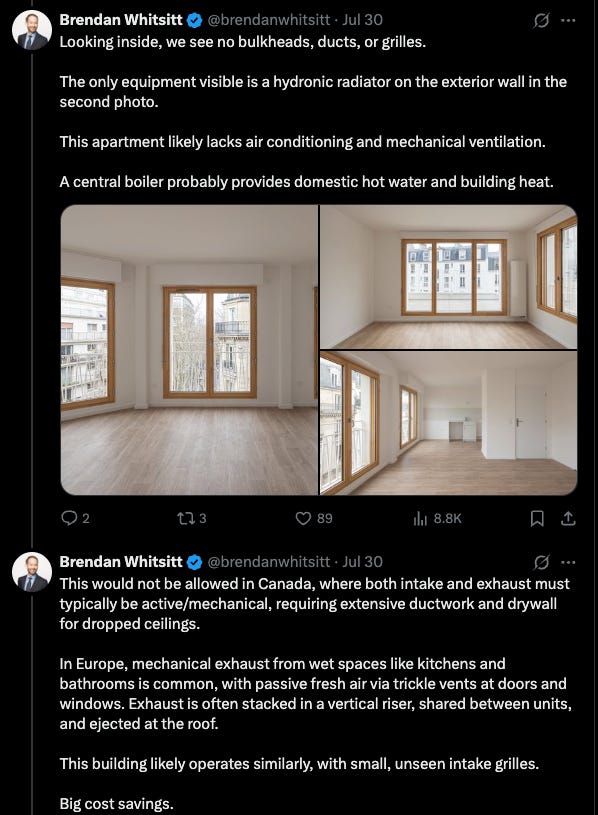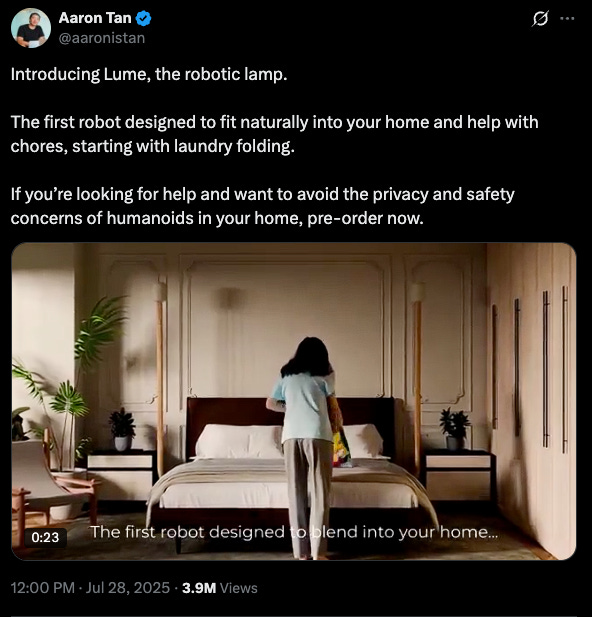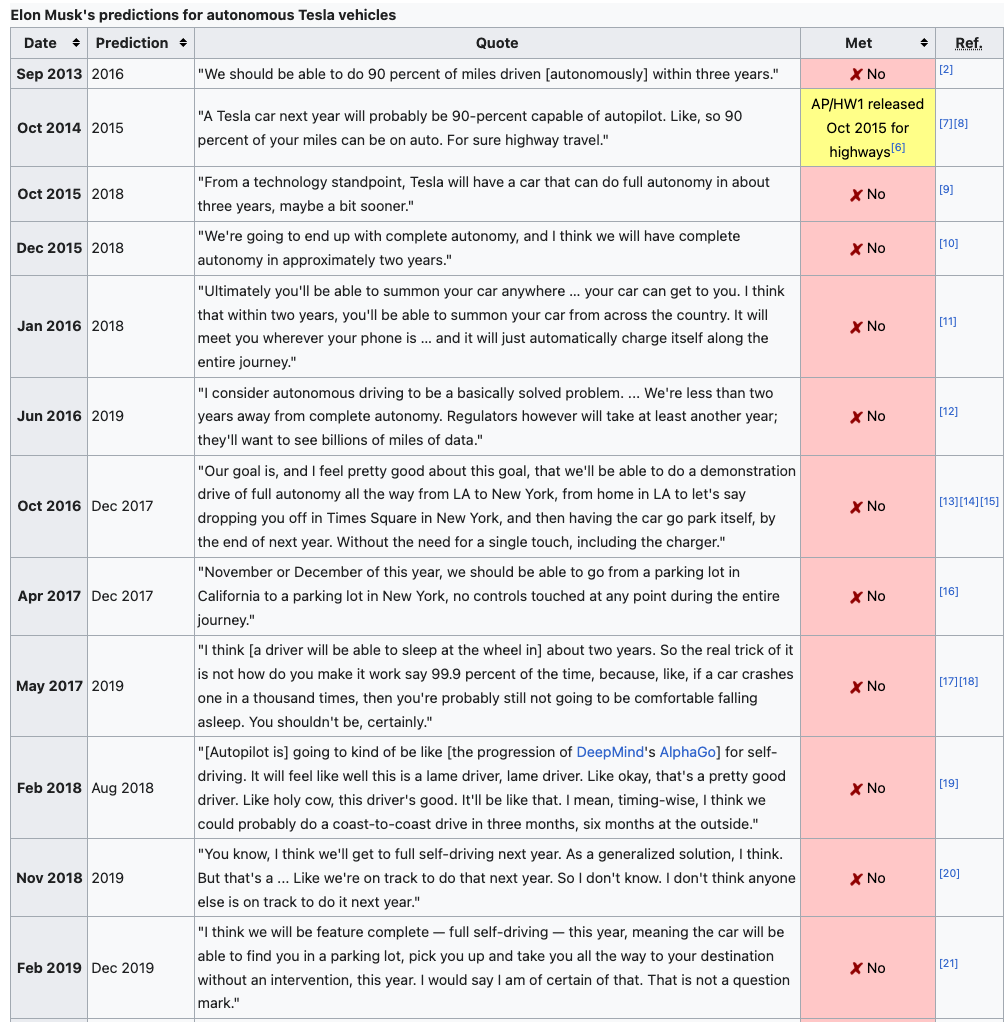Reading List 08/02/2025
European multifamily construction, a robot lamp, China’s self-driving car test, a “mini Moravec's paradox”, and more.

Welcome to the reading list, a weekly roundup of news and links related to buildings, infrastructure, and industrial technology. This week we look at European multifamily construction, a robot lamp, China’s self-driving car test, a “mini Moravec’s paradox”, and more. Roughly 2/3rds of the reading list is paywalled, so for full access become a paid subscriber.
No essay this week, but I’m working on a more involved piece about the nature of technological progress that should be out next week.
Housing monopolies
A line of argument I haven’t been paying much attention to but has (apparently) been gaining traction is the idea that recent increases in housing costs are driven by monopolies in homebuilding. This theory has been advanced by folks like Matt Stoller, but evidently it's gaining currency with others as well.
This theory didn’t seem completely crazy to me, as over the past several years homebuilding has steadily gotten more concentrated. It used to be that the 10 largest homebuilders were responsible for a very small fraction of total homes built in the US, but today they’re responsible for an increasingly large share. But I had never really looked into the idea.
However, a good piece by Derek Thompson on his substack lets some air out of this theory:
It is a fact that home prices across the country have increased in the last decade. It is also a fact that homebuilders have gotten bigger in the last few years. The question at stake here is: Is the second fact causing the first fact?
I believe there is only one economic paper that unambiguously says yes. It is a 2023 working paper entitled “Fewer players, fewer homes: concentration and the new dynamics of housing supply” by the economist Luis Quintero. This research is load-bearing in the antitrust world. It’s quoted in articles and social media posts by the antitrust advocate Matt Stoller. You’ll find it in research from other antitrust scholars. And it seems to be the only empirical research in Musharbash’s essay.
I called Luis Quintero to ask what level of market concentration in homebuilding he considered to be dangerous. In the most concentrated markets, Quintero said, one or two firms account for 90 percent of new housing. But problems begin to accelerate, he said, if five or six firms account for 90 percent of new housing.
…I tracked down a complete listing of the country’s 50 largest homebuilding markets, from #1 Dallas to #50 Cincinnati. How many meet Quintero’s first oligopoly threshold (two companies = 90 percent of the market)? Zero out of 50. And how many meet his second threshold (six companies = 90 percent of the market)? One: Cincinnati. It turns out that the largest homebuilding markets just aren’t that concentrated, even when you accept the yardstick of the economist who’s offered the only empirical definition of market concentration in homebuilding that I can find.
European multifamily construction
It’s become clear that for many types of construction, European countries have much lower construction costs than the US does. Transit and subway construction is the most famous example of this, but it's my sense that in multifamily apartment construction, Europe is also often substantially cheaper.
With transit construction, some of this comes down to improved efficiency and lower labor costs, but some of it comes down to differences in what gets built: US transit apparently often has much larger, more expensive stations than European transit. It seems like something similar might be true for multifamily construction as well. On Twitter, developer Brendan Whitsitt looks at a recent multifamily project in Paris, and lays out the many differences which allow it to be built for less than a similar project in Canada (which I believe will be fairly similar to US requirements.)
Robot lamp
I’ve spent a bit of time discussing humanoid robots, and considering whether a humanoid form factor will win out, or if other robot form factors might make more sense. In that vein, here’s a company developing a robotic floor lamp, Lume, that will (supposedly) autonomously fold clothes for you when it's released in 2026:
It’s not clear how close they are to an actual working robot (the video is entirely simulated, and I’d be surprised if they end up using a form factor that has so many joints/degrees of freedom), but if this seems compelling, you can place a reservation for the lamp here.
Elon Musk’s self driving car predictions
Tesla has been working on self-driving cars since at least 2013, and has been shipping Autopilot hardware since at least 2014. Over the years, Elon Musk has frequently made predictions about when various self-driving capabilities will be available, which have reliably proved to be overly optimistic. Wikipedia has a helpful list of every prediction Elon Musk has made around self-driving cars, and the status of that prediction.
The list includes 29 predictions in total. Of these, 1 has been met, 3 have been partially met, 7 might still be met but haven’t yet, and 18 haven’t been met.




